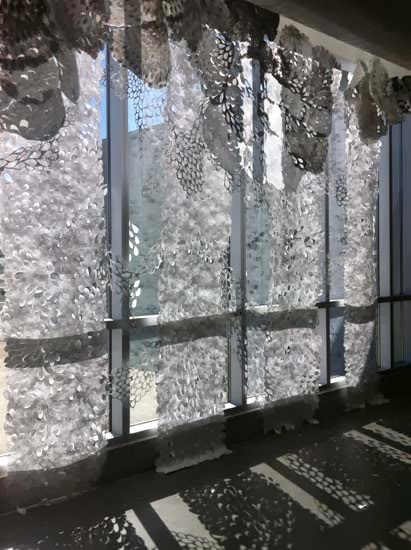
Window Art Evokes Patterns of Nature
 |
| Allison Svoboda, Urban Institute of Contemporary Art, Installation, 2013 Vortices, cut and painted paper, 40’x12′ |
 In art history classes, we learn that Renaissance artists made their paintings based on the vision of recreating a scene as if looking out a window, its frame becoming the defining edges from which to compose the painting. They created aerial and linear perspective to show how things look in the distance from that point of view.
In art history classes, we learn that Renaissance artists made their paintings based on the vision of recreating a scene as if looking out a window, its frame becoming the defining edges from which to compose the painting. They created aerial and linear perspective to show how things look in the distance from that point of view.
Artists are no longer tied to those constrictions of creating illusions, so what about turning the windows into art? There’s some artists who’ve done exactly that, while at the same time evoking and imitating patterns of nature and the weather. Here’s a few good examples.
Allison Svoboda is a paper artist is Chicago. Her sophisticated Vortices were a 40′ x 12″ installation exhibited at the Urban Museum of Contemporary Art, Grand Rapids, last year.
 Organic paper constructions ebb and flow, reminding us of the elements. We can think of the must beautiful aspects of rain and snow when looking out and about her handmade constructions. There’s white, gray, black and blue, all the colors evocative of weather phenomena and shapes to express its temperamental nature. Svoboda explains that it is the enormous energies of nature which inspire her. “The theory of fractal geometry; infinite layers of self-similar shapes repeated in every living thing, hold an endless fascination for me.”
Organic paper constructions ebb and flow, reminding us of the elements. We can think of the must beautiful aspects of rain and snow when looking out and about her handmade constructions. There’s white, gray, black and blue, all the colors evocative of weather phenomena and shapes to express its temperamental nature. Svoboda explains that it is the enormous energies of nature which inspire her. “The theory of fractal geometry; infinite layers of self-similar shapes repeated in every living thing, hold an endless fascination for me.”
Light flows inside Svoboda’s window art, but the papers give nuances of shade, and great contrast when hitting against blue skies. There’s also wonderful floor patterns created from light and shadow. Of course, these patterns shift and change as the day goes on. Paper is the medium. I’m guessing that loads of other materials could be used as creatively.
Vortices are natural occurring whirlpools in nature. Another piece of window art I saw imitates a calmer quality of nature. When on a trip to Healdsburg, California, an amazing work of environmental art had recently been made for the Spoon Bar, the restaurant at H2Hotel. Northern California artist Ned Kahn made a sculptural installation for the site, a magical window vista called Spoonfall.
Upon further inspection and discovery, small streams of water were falling down a vertical grid interspersed with spoons. As the spoons swung up and down, water landed from one spoon to the next. Everything sparkled, especially as water hit metal and captured reflections of light. The trickling flow of water made the sounds very soothing and comforting, calming an atmosphere that could have become too noisy.
As Kahn says, he see patterns which enhance our perception of natural phenomena. He typically makes art works which incorporate water, fog, wind and/or light and fire, i.e. elements of nature. His works include vortices, too. Kahn has always been fascinated with the confluence of art and science.
Recreating different kinds of movements and flows make us more keenly aware of the patterns in nature. In that way, Svoboda and Kahn are much alike, but their materials—simple paper for Svoboda, water and metal for Kahn—could not be more different. These artists make us see and understand our world so much better.
 |
| Ned Kahn, Spoonfall, 2010, Spoon Bar Restaurant at the H2Hotel, Healdsburg, CA |


Recent Comments